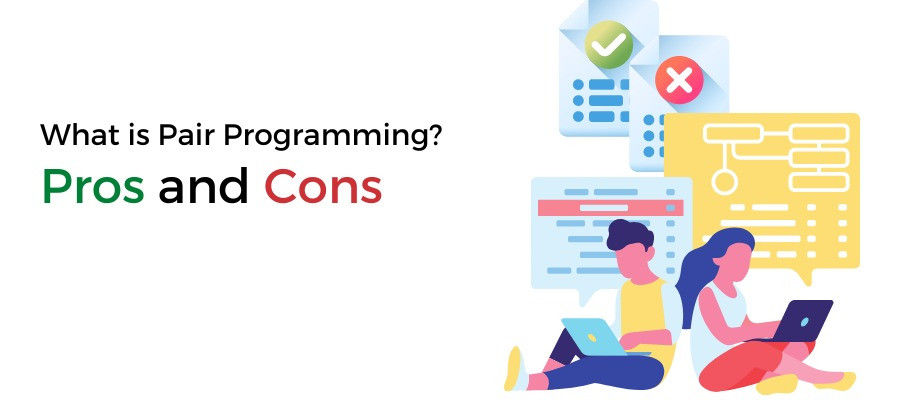What is Pair Programming Pros and Cons

Many people mistakenly believe that software engineering is a solitary discipline. However, like many other pursuits, collaborative teamwork is crucial in resolving programming challenges with incredible speed and efficiency. This blog explores the concept of pair programming, highlighting its significant pros and cons.
What is Pair Programming?
Pair programming is a collaborative software development approach where two programmers work together on a shared workstation simultaneously. This cooperative effort can occur either in person or remotely, necessitating screen sharing and real-time editing tools.
The process involves two distinct roles that programmers alternate between. One assumes the driver's role, responsible for writing the code, while the other takes the navigator role, reviewing the code and offering guidance and instructions. The parts are swapped at regular intervals, typically 15 minutes to 1 hour.
Pair programming remains a subject of considerable debate within many organizations. Some embrace it enthusiastically, while others staunchly reject its adoption. In the following sections, we will explore the advantages and disadvantages of pair programming, shedding light on the perspectives behind these varying stances.
The Pros of Pair Programming
- Reduced errors and bugs:
Software Developers may fall victim to stubbornness or tunnel vision when working alone, making it easy to overlook mistakes or struggle to fix bugs based on incorrect assumptions. Pair programming mitigates this risk by promoting teamwork and shared problem-solving. The combined experience and knowledge of both partners lead to faster issue resolution. Research from the University of Utah indicates that code produced through pair programming exhibits 15 percent fewer defects.
Pair programming also facilitates the practice of "rubber duck debugging." By explaining their code line by line to their partner, Developers can uncover their misconceptions and biases, allowing for quicker recovery from roadblocks.
- Enhanced resilience:
The concept of the "bus factor" concerns mature software development teams. If a critical team member is suddenly unavailable due to unforeseen circumstances, valuable technical knowledge can be lost or take significant time to recover. Pair programming addresses this issue by ensuring that multiple individuals are well-versed in all aspects of the codebase, reducing the impact of personnel changes and potential project delays.
- Improved code quality:
Pair programming fosters the exchange of best practices between partners, resulting in higher-quality code overall. The accountability to one's partner discourages using shortcuts or hacks, encouraging the development of robust solutions that minimize the likelihood of future bugs.
- Accelerated training:
Pair programming is often practiced between experts or a combination of experts and novices. In the latter scenario, pair programming becomes a valuable tool for junior or new team members to learn from their more experienced colleagues. This accelerated knowledge transfer expedites the onboarding process and helps develop the skills of less experienced team members.
- Enhanced Team Morale
Pair programming not only provides a collaborative environment but also fosters a sense of camaraderie among team members. Having a partner to engage with on the project allows for empathetic discussions and problem-solving, preventing individuals from feeling stuck and unproductive. This, in turn, contributes to increased overall team productivity and happiness. Most practitioners (96 percent) of pair programming report greater enjoyment of their job compared to working alone.
The Cons of Pair Programming
- Increased costs:
Pair programming involves dedicating two Developers to a single task, which may be perceived as an inefficient use of resources. Indeed, pair programming may not complete a project in half the time.
However, the additional investment in overhead costs is often offset by the higher quality of code produced and the overall efficiency and effectiveness of the outcome. The upfront costs are balanced by reduced maintenance efforts over the project's lifespan.
- Sustainability:
Pair programming is not always sustainable to practice continuously. The ideal duration for pair programming sessions is typically around 2 to 2.5 hours, with breaks included. It is essential to balance the intensity of pair programming to avoid mental fatigue or burnout. Introducing variety by switching to different projects or partners throughout the day can help keep the mind fresh and maintain productivity.
Despite these potential challenges, the benefits of pair programming, such as improved code quality, error reduction, and accelerated knowledge transfer, often outweigh the drawbacks. Teams must consider their project requirements and team dynamics when deciding the frequency and duration of pair programming sessions.
Wrapping up
Pair programming offers numerous advantages in software development. It promotes collaboration, reduces errors, enhances resilience, improves code quality, and accelerates training for junior team members. Additionally, it fosters team morale and happiness, creating a more productive and enjoyable work environment.
However, pair programming also presents challenges, including increased costs and the need for sustainable practices. By carefully considering the unique needs of their projects and teams, organizations can leverage the benefits of pair programming while effectively managing its potential drawbacks. Adopting pair programming as a collaborative approach can lead to more efficient and successful software development endeavors.
Reference
- https://www.verytechnology.com/iot-insights/the-pros-and-cons-of-pair-programming



